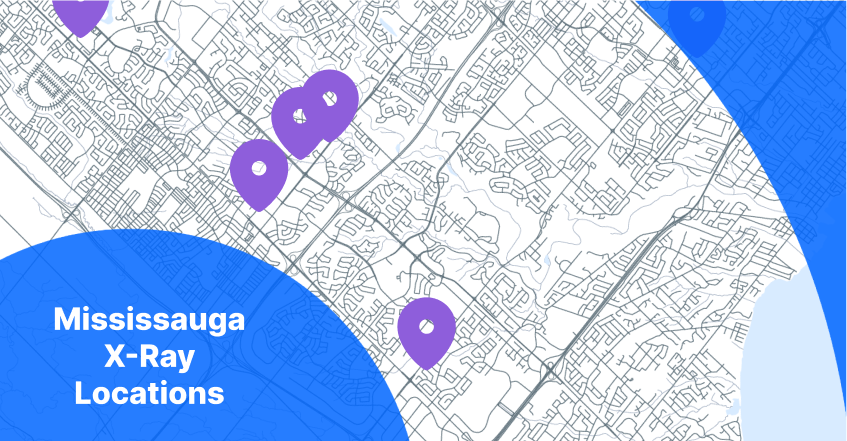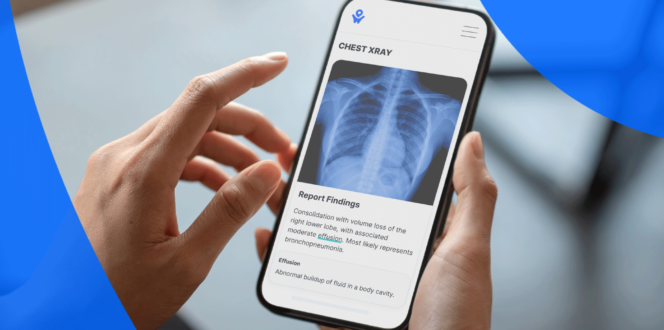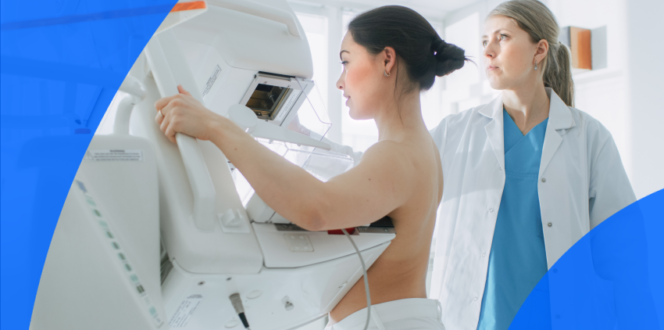Getting an X-Ray in Mississauga? Here’s What to Know and Where to Go

If you’re booking an X-ray in Mississauga, here’s the information you need to find a clinic, avoid long wait times and get your results faster.
A medical X-ray uses very low-dose radiation to make images of the internal structures of your body. Healthcare professionals often use X-rays to diagnose or monitor the treatment of illnesses and injuries.
This article will give you the information you need to know before getting an X-ray in Mississauga, such as:
- Why you might need an X-ray
- Where you can get an X-ray in Mississauga
- How to properly prepare for your X-ray
- How quickly you can access your X-ray results
Why get an X-ray?
A doctor might refer you to book an X-ray to help diagnose or monitor a specific illness or injury. The body part you have X-rayed will depend on what kind of symptoms you display. For example:
- If you present symptoms that are associated with gallbladder issues, kidney stones or other abdominal blockages, you might need an abdominal X-ray.
- If you have a potential fracture, or to diagnose issues in your joints, you may need a bone X-ray.
- If you show signs of bronchitis or pneumonia, you could get referred for a chest X-ray.
- As part of regular breast cancer screening or as a diagnostic X-ray if you notice any breast abnormalities, you’ll get a specialized breast X-ray called a mammogram.
- To measure the mineral density of your bones, you might need a dual energy X-ray absorptiometry (DXA) scan.
When to get an ultrasound over an X-ray?
Doctors use both X-rays and ultrasounds to diagnose and monitor internal conditions. X-rays use electromagnetic radiation to create images of the internal structures of your body. Although X-rays use a very low dose of radiation, avoiding them while pregnant is recommended. Ultrasounds use sound waves instead, which makes them a better choice for prenatal imaging.
In addition to providing pregnancy and prenatal monitoring, ultrasounds are often used to provide images of internal soft tissues and organs. X-rays are more penetrative than ultrasounds, especially when it comes to the hard structures of the body like bones. X-rays are often used to examine bone injuries and illnesses and to provide detailed images of areas otherwise occluded by bones (e.g. lung tissue beneath your ribs).
Where to get an X-ray in Mississauga
As with an ultrasound, you will most likely book your X-ray yourself. Your referring doctor will give you a requisition with which you can make an appointment with an imaging clinic. You’re unlikely to book an X-ray at a hospital. If you’re admitted to a hospital and require an X-ray, it will be arranged for you.
You’ll likely want to locate a medical imaging clinic in your area. Your doctor’s office might be able to recommend X-ray clinics near you. There are several imaging clinics and hospitals in Mississauga that provide many different types of X-rays, including:
- Bluewater Imaging
- Credit Valley Diagnostic Centre
- Credit Valley X-Ray & Ultrasound
- Dixie X-ray Associates
- GAM Diagnostic Imaging
- GNMI – Mississauga
- Mississauga Diagnostic Imaging & Breast Centre
- Mississauga Hospital – Trillium Health Partners
- The Credit Valley Hospital – Trillium Health Partners
- WELL Health Diagnostic Centres Mississauga
If you don’t have a requisition but want an X-ray, you also have the option to book through a private medical imaging clinic. You will have to pay for it yourself though, and X-ray fees can be expensive.
How long does it take to get an X-ray appointment?
Many clinics offer walk-in X-ray services, which allow you to get your X-ray done the same day. However, it depends on both the clinic you choose and the kind of X-ray you need. For specialized X-rays like mammograms, for instance, you might have to wait for several weeks.
There are ways to shorten your waiting time. Consider traveling to an alternate clinic location. Set your appointment for off-peak hours, late into the night or early in the morning. Or ask to be waitlisted for any last-minute cancellations.
How much does it cost to get an X-ray in Mississauga?
In Mississauga and the rest of Ontario, OHIP will cover the cost of a medical X-ray if:
- It is deemed medically necessary (i.e., dental X-rays are not covered)
- Your doctor provides a requisition
If you have an acute injury, a pressing concern, or if there is a serious condition in your health history, you might elect to pay for an X-ray at a private clinic. Each clinic sets its own fees, so the cost will be contingent on the clinic you select and the type of X-ray you need.
How to prepare for your X-ray
X-rays are non-invasive scans, but there are things you can do to prepare, like:
- Bring your requisition to your appointment, as it has important information describing the type of X-ray you need.
- Wear comfortable clothing you can get into and out of easily, as your X-ray may require you to partially remove what you’re wearing.
Some X-rays have additional requirements. It’s important to check with the imaging clinic ahead of time to learn if you:
- Need to refrain from eating or drinking before your appointment, and for how many hours. This is often necessary for abdominal X-rays.
- Will be required to take anything before your X-ray. Gastrointestinal (GI) X-rays sometimes require you to ingest a contrasting dye or have a barium enema during your appointment.
Your X-ray technician is not legally allowed to answer questions about your X-ray results, but you can ask questions about the X-ray process itself, such as:
- How long will my appointment last?
- Can someone join me in the room for support?
- Will I get access to the image files in the same format as my doctor?
How quickly can you get your X-ray results?
Your X-ray technologist will send your images to a radiologist, who will interpret them and prepare a report. The radiologist will send the report and images to your referring doctor, who will then set up a follow-up appointment with you to review your results. If you booked your X-ray at a private imaging clinic, you will have to reach out to your doctor yourself to book an appointment to go over any findings.
You can also access your X-ray images and report through PocketHealth, sometimes even before your follow-up appointment. With PocketHealth, you can access, share, and store all your medical images and reports in one secure location. Access your records here.
PocketHealth Report Reader also makes it easy for you to understand the medical terms in your X-ray report and highlights any follow-up recommendations so you’ll be confident and fully informed at your follow-up appointment.
If you choose to have X-rays taken at a private clinic, you can share your report and diagnostic-quality images directly with your doctor through the PocketHealth platform.
How to understand your X-ray results
Your X-ray results will include both images and a report from the radiologist detailing any findings. The images will show your internal body structures in shades of grey against a dark background. Dense components like bone appear white, while soft tissues and organs are shades of grey. Among other things, the radiologist will assess your X-ray images for:
- Density: denser structures appear lighter in X-rays.
- Lucency: dark spots on X-rays appear dark.
- Undulations: uneven or wavy spots or sections on an X-ray.
The report will outline any abnormalities in contrast, location or size. Depending on the type of X-ray, common findings could include:
- Osseous lesion: Abnormalities found in the bone, such as a benign or malignant tumor.
- Fracture: A partial or complete break of a bone. There are several types of fractures, including stable, compound (bone pierces skin), transverse (horizontal) and oblique (angled).
- T-score: A DXA scan (bone density X-ray) compares your bone density to the average bone density score of a healthy 30-year-old. Your T-score helps determine fracture risk and whether you’re at risk of developing osteoporosis as you age.
- Z-score: Delivered with the T-score, a Z-score compares your bone density to the average person of the same age, sex and size. This is more helpful for children, teenagers and premenopausal women, who are at risk for osteoporosis due to underlying medical conditions.
- BI-RADS category: A breast x-ray (i.e., mammogram) uses the Breast Imaging Reporting and Data System (BI-RADS) to report findings. The low end of the range (category 0-3) suggests incomplete, negative or benign findings, while the high end (category 4-6) suggests suspicious or malignant findings.
- Breast density category: A mammogram also determines breast density, which is the amount of fatty tissue in the breast. Findings range from extremely fatty tissue (Category A) to extremely dense tissue (Category D). Higher breast density is correlated to high breast cancer risk.
PocketHealth Report Reader can help you understand terms in your report, like the ones outlined above. But it’s still important to have a follow-up appointment with your doctor to go over any questions you may have about your results and plan the next steps.
Ready to advocate for your health?
Painless and non-invasive, X-rays provide your doctor with detailed and valuable information to diagnose or treat illnesses or injuries. If you’re in Mississauga, you have several imaging clinics to choose from when booking an X-ray. You also have the option to gain access to your own X-ray images and report at the same time as your doctor, with PocketHealth.
How PocketHealth works
Learn more about how to use PocketHealth to access and share your X-ray results.
Published: October 18, 2023
Trusted by more than 800+ hospitals and clinics.



















